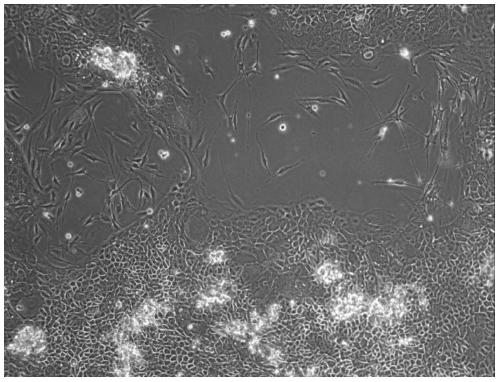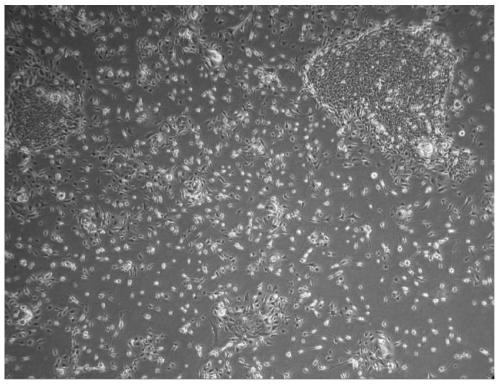A method for culturing melanocytes
A technology of melanocytes and culture methods, applied in animal cells, vertebrate cells, artificial cell constructs, etc., can solve the problems of low proliferation and differentiation activity, low proportion and total number of melanocytes, and achieve good activity and adhesion performance Maintain a good effect of promoting proliferation
- Summary
- Abstract
- Description
- Claims
- Application Information
AI Technical Summary
Problems solved by technology
Method used
Image
Examples
Embodiment 1
[0053] Add 20 mL of DMEM medium, penicillin, and streptomycin (penicillin 100 units / mL; streptomycin 100 μg / mL) into a 50 mL centrifuge tube as a skin bleb preservation solution.
[0054] Add 1mL, 10g / L type I collagenase into a Φ60mm Petri dish and set aside. Put the isolated epidermis (acquired by sucking blisters, 8-15 sucking blisters) into the above-mentioned petri dish, and use ophthalmic scissors to cut the epidermis into pieces of 2mm×2mm.
[0055] After shredding, add 1 mL of 2.5 g / L trypsin·0.38 g / L EDTA solution to the petri dish, put it in a 37°C incubator for 1 hour.
[0056] Every half hour, take out the petri dish and observe the status of digestion under the microscope. After 1 hour, the petri dish was taken out and the skin fragments were blown and observed under a microscope. If it was found that the cells on the epidermis were basically completely digested, the pre-medium was added to terminate the digestion.
[0057] Recover the digested skin pieces and s...
Embodiment 2
[0070] Add 20 mL of DMEM medium, penicillin, and streptomycin (penicillin 100 units / mL; streptomycin 100 μg / mL) into a 50 mL centrifuge tube as a skin bleb preservation solution.
[0071] Add 1mL, 10g / L type I collagenase into a Φ60mm Petri dish and set aside. Put the isolated epidermis (acquired by sucking blisters, 8-15 sucking blisters) into the above-mentioned petri dish, and use ophthalmic scissors to cut the epidermis into pieces of 2mm×2mm.
[0072] After shredding, add 1 mL of 2.5 g / L trypsin·0.38 g / L EDTA solution to the petri dish, put it in a 37°C incubator for 1 hour.
[0073] Every half hour, take out the petri dish and observe the status of digestion under the microscope. After 1 hour, the petri dish was taken out and the skin fragments were blown and observed under a microscope. If it was found that the cells on the epidermis were basically completely digested, the digestion was terminated.
[0074] The digested skin pieces and suspension were recovered into a...
Embodiment 3
[0078] Add 20 mL of DMEM medium, penicillin, and streptomycin (penicillin 100 units / mL; streptomycin 100 μg / mL) into a 50 mL centrifuge tube as a skin bleb preservation solution.
[0079] Add 1mL, 10g / L type I collagenase into a Φ60mm Petri dish and set aside. Put the isolated epidermis (acquired by sucking blisters, 8-15 sucking blisters) into the above-mentioned petri dish, and use ophthalmic scissors to cut the epidermis into pieces of 2mm×2mm.
[0080] After shredding, add 1 mL of 2.5 g / L trypsin·0.38 g / L EDTA solution to the petri dish, put it in a 37°C incubator for 0.5 hours.
[0081] Every 15 minutes, remove the Petri dish and observe the digestion status under the microscope. After 0.5 h, take out the petri dish and blow the skin fragments, observe under a microscope, if it is found that the cells on the epidermis are basically completely digested, then add the pre-culture solution to stop the digestion.
[0082] The digested skin pieces and suspension were recovere...
PUM
 Login to View More
Login to View More Abstract
Description
Claims
Application Information
 Login to View More
Login to View More - R&D
- Intellectual Property
- Life Sciences
- Materials
- Tech Scout
- Unparalleled Data Quality
- Higher Quality Content
- 60% Fewer Hallucinations
Browse by: Latest US Patents, China's latest patents, Technical Efficacy Thesaurus, Application Domain, Technology Topic, Popular Technical Reports.
© 2025 PatSnap. All rights reserved.Legal|Privacy policy|Modern Slavery Act Transparency Statement|Sitemap|About US| Contact US: help@patsnap.com



